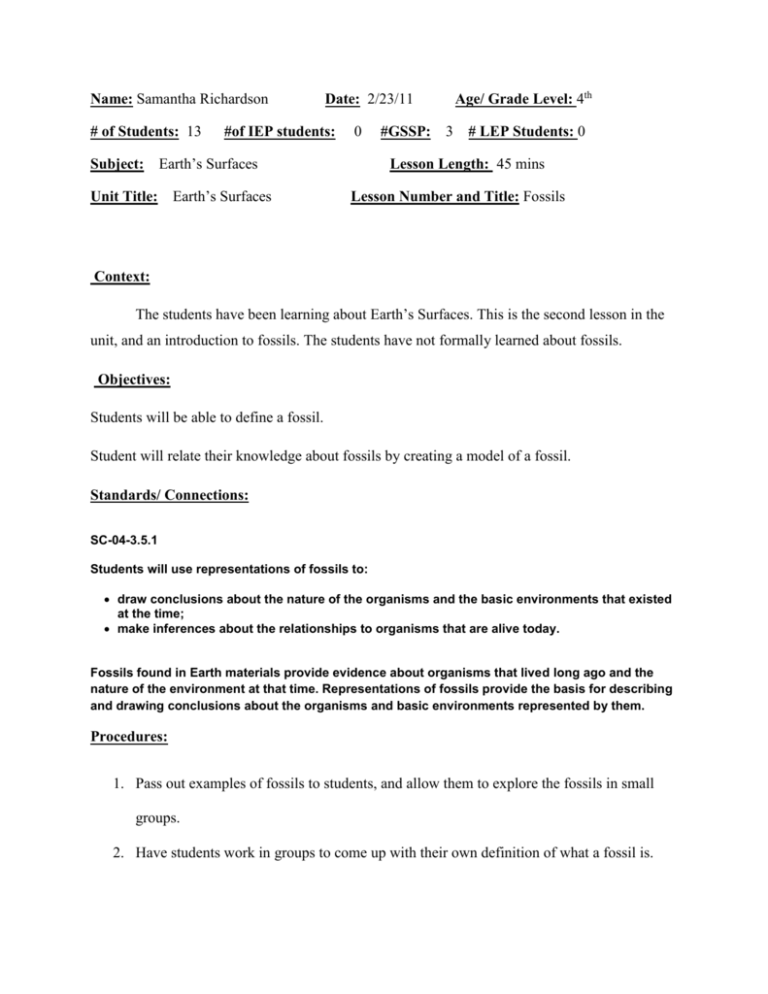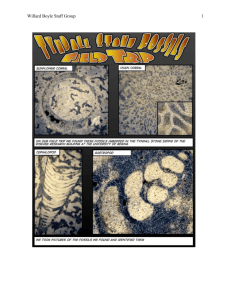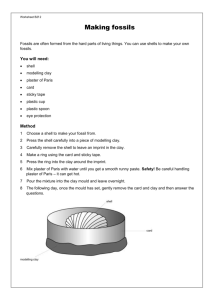Fossils - Georgetown College
advertisement

Name: Samantha Richardson # of Students: 13 #of IEP students: 0 Subject: Earth’s Surfaces Unit Title: Earth’s Surfaces Age/ Grade Level: 4th Date: 2/23/11 #GSSP: 3 # LEP Students: 0 Lesson Length: 45 mins Lesson Number and Title: Fossils Context: The students have been learning about Earth’s Surfaces. This is the second lesson in the unit, and an introduction to fossils. The students have not formally learned about fossils. Objectives: Students will be able to define a fossil. Student will relate their knowledge about fossils by creating a model of a fossil. Standards/ Connections: SC-04-3.5.1 Students will use representations of fossils to: draw conclusions about the nature of the organisms and the basic environments that existed at the time; make inferences about the relationships to organisms that are alive today. Fossils found in Earth materials provide evidence about organisms that lived long ago and the nature of the environment at that time. Representations of fossils provide the basis for describing and drawing conclusions about the organisms and basic environments represented by them. Procedures: 1. Pass out examples of fossils to students, and allow them to explore the fossils in small groups. 2. Have students work in groups to come up with their own definition of what a fossil is. 3. As a class have students share what their groups decide a fossil is. Combine the groups’ definitions into one class definition. 4. Have the students record this definition in their science journals. 5. Then allow student to work in groups to come up with how they think fossils are formed. 6. Have another group discussion about how fossils are formed. 7. Draw a diagram on the board showing how and animal is covered with sedimentary rock, and then pressed down to form a fossil. Have students record the information about how fossils are formed in their science journals. 8. Ask the students what things they think can be made into fossils. Have the students come up with the following things that can be made into fossils: shells, plants, animals, footprints, and anything else that they can think of. 9. Pass out to each student a piece of modeling clay and a small plastic container. Instruct the students to roll the clay and place in the plastic container pressing it to the sides. 10. Then allow students to pick out a shell to create a fossil of. 11. Have the students press the shell in the clay, and the remove the shell leaving an impression in the clay. 12. Go around to each student and pour plaster of paris over their clay. 13. As a class discuss each of the parts of making a fossil. Have students explain how each step of making the fossils with the clay relates to how fossils are formed in real life. 14. After the plaster has dried have the students use magnify glasses to examine their fossil. 15. Have the students draw a model of their fossil in their science notebooks, and record how this fossil relates to how fossils are formed on the Earth’s surface. Assessment: Objective Number Type of Assessment Assessment Title Depth of Knowledge Obj. 1 Formative Group work/ having students present 1 Obj.2 Summative Group work/ having students create their own fossil, and recording it in their science journals. 2 Adaptations/ Accommodations Students will be working in pairs to come up with the definition. There were no adaptations.





